The human eye and Colourful world
The Human Eyes And The Colorful World
Question 1:
What kind of lens is present in the human eye ?
Solution :
Convex lens
Question 2:
Name two parts of the eye which refract light rays (or bend light rays)
Solution :
Two parts which refract light rays are cornea and eye-lens.
Question 3:
Name the part of the eye :
(a) which controls the amount of light entering the eye.
(b) on which the image is formed.
(c) which changes the focal length of eye-lens.
Solution :
(a) Iris
(b) Retina
(c) Ciliary muscles
Question 4:
What is the name of :
(a) the curved, transparent front surface of the eye ?
(b) the light-sensitive layer in the eye ?
Solution :
(a) Cornea
(b) Retina
Question 5:
Where is the image formed in a human eye ?
Solution :
At retina
Question 6:
What is the function of the lens in the human eye ?
Solution :
Eye lens changes its shape and thickness to focus light on to the retina.
Question 7:
What job does the pupil of the eye do ?
Solution :
Pupil expands or contracts according to the intensity of light around the eye.
Question 8:
Flow does the eye adjust to take account of an increase in brightness ?
Solution :
The pupil of our eye contracts.
Question 9:
Name that part of the eye which is equivalent to the photographic film in a camera.
Solution :
Retina
Question 10:
Name the part of the retina which is insensitive to light.
Solution :
Blind spot
Question 11:
Which part of the eye contains cells which are sensitive to light ?
Solution :
Retina
Question 12:
Name two types of cells in the retina of an eye which respond to light.
Solution :
Rods and cones
Lakhmir Singh Physics Class 10 Solutions Page No:170
Question 13:
Out of rods and cones in the retina of your eye :
(a) which detect colour ?
(b) which work in dim light ?
Solution :
(a) Cones
(b) Rods
Question 14:
State whether the following statement is true or false :
The image formed on our retina is upside-down
Solution :
True
Question 15:
What is the principal function of the eye-lens ?
Solution :
The principal function of the eye-lens is to focus light on to the retina.
Question 16:
Where does the greatest degree of refraction of light occur in the eye ?
Solution :
At cornea
Question 17:
What changes the shape of lens in the eye ?
Solution :
Ciliary muscles
Question 18:
What do the ciliary muscles do when you are focusing on a nearby object ?
Solution :
The ciliary muscles make the eyes lens thicker (more converging).
Question 19:
What is the least distance of distinct vision for a normal human eye ?
Solution :
The least distance of the distinct vision for a normal human eye is about 25cm.
Question 20:
What is the :
(a) far point of a normal human eye ?
(b) near point of a normal human eye ?
Solution :
(a) The far point of a normal human eye is at infinity.
(b) The near point of a normal human eye is at 25cm from the eye.
Question 21:
What is the range of vision of a normal human eye ?
Solution :
Range of vision of a normal human eyes is from infinity to about 25cm.
Question 22:
Name the part of our eyes which helps us to focus near and distant objects in quick succession.
Solution :
Ciliary muscles
Question 23:
Define the term “power of accommodation” of human eye
Solution :
The ability of an eye to focus the distant objects as well as the nearby objects on the retina by changing the focal length of its lens is called the power of accommodation.
Question 24:
Give the scientific names of the following parts of the eye :
(a) carries signals from an eye to the brain.
(b) muscles which change the shape of the eye-lens.
(c) a hole in the middle of the iris.
(d) a clear window at the front of the eye.
(e) changes shape to focus a picture on the retina.
Solution :
(a) Optic nerve
(b) Ciliary muscles
(c) Pupil
(d) Cornea
(e) Eye lens
Question 25:
Fill in the following blanks with suitable words :
(a) Most of the refraction of light rays entering the eye occurs at the outer surface of the………….
(b) The part of eye sensitive to light is…………….
(c) The part of eye which alters the size of the pupil is………….
(d) When light is dim, the pupil becomes…………
(e) The iris controls the amount of…………… entering the eye.
(f) The ciliary muscles control the shape of the…………..
(g) To bring light from a distant object to a focus on the retina of the eye, the convex eye-lens needs to be made……
(h) To bring light from a near object to a focus on the retina of the eye, the convex eye-lens needs to be made……
Solution :
(a) cornea
(b) retina
(c) iris
(d) large
(e) light
(f) eye-lens
(g) thinner
(h) thicker
Question 26:
Why is a normal eye not able to see clearly the objects placed closer than 25 cm ?
Solution :
The normal eye is not able to see clearly the objects placed closer than 25 cm because all the power of accomodation of the eye is exhausted at a distance of 25 cm. The maximum accomodation of the eye is reached when the object is placed at 25 cm fro the eye. After this the ciliary muscles cannot make the eye-lens more thick.
Question 27:
What changes take place in the shape of eye-lens :
(a) when the eye is focused on a near object ?
(b) when the eye is focused on a distant object ?
Solution :
(a) Eye-lens becomes thicker.
(b) Eye-lens become thinner.
Question 28:
The eyes of a person are focused
on a nearby object, and
on a distant object, turn by turn. In which case :
(a) the focal length of eye-lens will be the maximum ?
(b) the converging power of eye-lens will be the maximum ?
Solution :
(a) When the eye is focused on a distant object.
(b) When the eye is focused on a nearby object.
Question 29:
What change is made in the eye to enable it to focus on objects situated at different distances ? Illustrate your answer with the help of diagrams.
Solution :
To focus on distant objects, the ciliary muscles of the eye get fully relaxed and pull the suspensory ligaments attached to the eye-lens tightly. This, in turn, stretches the eye-lens and the eye-lens becomes thin.
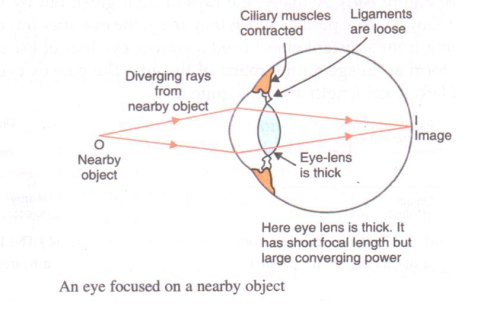
To focus on nearby objects, the ciliary muscles of the eyes contract and make the suspensory ligaments loose. The ligaments then stop pulling the eye-lens. The eye-lens bulges under its own elasticity and becomes thick.
Question 30:
How is the amount of light entering the eye controlled ?
Solution :
The amount of light entering the eye is controlled by the iris. It automatically adjusts the size of the pupil according to the intensity of light received by the eye. If the amount of light received by the eye is large, then the iris contracts the pupil and reduces the amount of light entering the eye. If the amount of light received by the eye is small, then the iris expands the pupil so that more light may enter the eye.
Question 31:
What happens to the eye when you enter a darkened cinema hall from bright sunshine ? Give reason for your answer.
Solution :
When we enter a darkened cinema hall from bright sunshine, at first we cannot see anything clearly. After a short time our vision improves. This is because in bright sunshine the pupil of our eye is small and when we just enter the darkened room very little light enters our eye due to which we cannot see properly. After a while, when the pupil of our eye expands, more light enters our eye and we can see clearly.
Question 32:
Why does it take some time to see objects in a dim room when you enter the room from bright sunshine outside ?
Solution :
It takes some time to see objects in a dim room when we enter the room from bright sunshine outside because it takes some time to the small pupil of our eye to become large so that more light enters our eye and we can see clearly.
Lakhmir Singh Physics Class 10 Solutions Page No:271
Question 33:
A person walking in a dark corridor enters into a brightly lit room :
(a) State the effect on the pupil of the eye.
(b) How does this affect the amount of light entering the eye ?
Solution :
(a) Pupil becomes smaller.
(b) The amount of light entering the eye is reduced.
Question 34:
Ciliary muscles of human eye can contract or relax. How does it help in the normal functioning of the eye ?
Solution :
Ciliary muscles get relaxed and the eye lens becomes thin when the eye is looking at a distant object, and these muscles contract and make the eye-lens thick when the eye is looking at a nearby object. Thus, ciliary muscles help in the normal functioning of the eye by changing the thickness of the eye-lens while focussing.
Question 35:
Describe and explain, how a normal eye can see objects lying at various distances clearly.
Solution :
To focus on distant objects, the ciliary muscles of the eye get fully relaxed and pull the suspensory ligaments attached to the eye-lens tightly. This, in turn, stretches the eye-lens and the eye-lens becomes thin. This thin eye-lens has large focal length and small converging power sufficient to converge the parallel rays of light coming from a distant object to form an image on the retina.
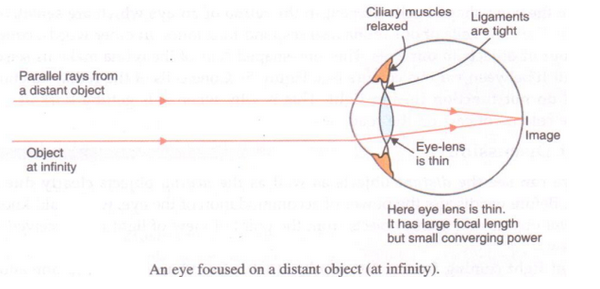
To focus on nearby objects, the ciliary muscles of the eyes contract and make the suspensory ligaments loose. The ligaments then stop pulling the eye-lens. The eye-lens bulges under its own elasticity and becomes thick. This thick eye-lens has small focal length and large converging power which converges the diverging rays coming from the nearby object to form an image on the retina.
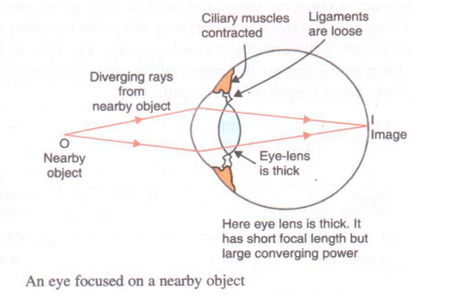
Question 36:
There are two types of light-sensitive cells in the human eye :
(a) Where are they found ?
(b) What is each type called ?
(c) To what is each type of cell sensitive ?
Solution :
(a) The two types of light-sensitive cells are found in the retina.
(b) They are called rods and cones.
(c) Rods are sensitive to dim light and cones are sensitive to bright light and colours.
Question 37:
What are rods and cones in the retina of an eye ? Why is our night vision relatively poor compared to the night vision of an
owl ?
Solution :
Rods are the rod-shaped cells present in the retina of an eye which are sensitive to dim light.
Cones are the cone-shaped cells present in the retina of an eye which are sensitive to bright light.
Our night vision is relatively poor compared to the night vision of an owl due to the presence of relatively smaller number of rod cells in the retinas of our eyes.
Question 38:
(a) How does the convex eye-lens differ from the ordinary convex lens made of glass ?
(b) List, in order, the parts of the eye through which light passes to reach the retina.
Solution :
(a) The focal length of the convex eye-lens can be changed by the action of ciliary muscles, but the focal length of the ordinary convex lens made of glass is fixed.
(b) Cornea, pupil, eye-lens, retina.
Question 39:
(a) What happens to the size of pupil of our eye
in dim light
in bright light ?
(b) Name the cells on the retina of an eye which are sensitive to
bright light
dim light
sensation of colour.
Solution :
(a)
In dim light, pupil becomes large.
in bright light, puoil becomes small.
(b)
Cones
Rods
Cones
Question 40:
(a) Draw a simple diagram of the human eye and label clearly the cornea, iris, pupil, ciliary muscles, eye-lens, retina, optic nerve and blind spot.
(b) Describe the working of the human eye with the help of the above diagram.
(c) How does the eye adjust itself to deal with light of varying intensity ?
Solution :
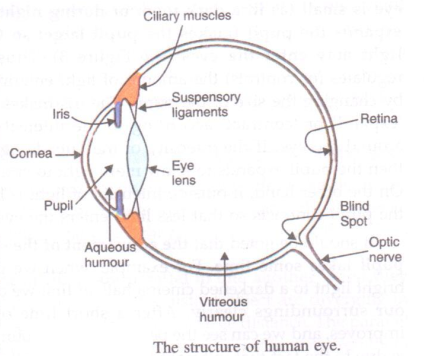
(b) Working of the human eye
The light rays coming from the object kept in front of the eye enter the cornea, pass through the pupil and fall on the eye lens. The eyes lens is convex lens, so it converges the light rays and produces a real and inverted image of the object on the retina. The image formed on the retina is conveyed to the brain by the optic nerve and gives rise to the sensation of vision.
(c) The eye adjusts itself to deal with ight of vaying intensity with the help of the iris. The iris automatically adjusts the size of the pupil according to the intensity of light received by the eye. If the intensity of light is large, then iris contracts the pupil and reduces the amount of light entering the eye. And, if the intensity of light is small, then iris expands the pupil so that more light may enter the eyes.
Question 41:
(a) Explain the functions of the following parts of the eye :
(a) cornea (b) iris (c) pupil (d) ciliary muscles (e) eye-lens(f) retina (g) optic nerve
(b) If you walk from a dark room into sunlight and back again into dark room, how would your pupils alter in size ? What makes this happen ?
(c) Explain why, we cannot see our seats first when we enter a darkened cinema hall from bright light but gradually they become visible.
Solution :
(a) a. Cornea: It is the front part of the eye. The light coming from objects enters the eye through cornea.
b. Iris: It controls the amount of light entering the eye.
c. Pupil: It controls the illumination in the eye.
d. Ciliary muscles: The focal length of the eye-lens can be changed by changing its shape by the action of ciliary muscles.
e. Eye-lens: It focuses light on to the retina.
f. Retina: It is a delicate membrane having a large number of light sensitive cells called ‘rods’ and ‘cones’ which respond to the intensity of light and colour of objects respectively.
g. Optic nerve: It conveyes the image formed on the retina to the brain.
(b) If we walk from a dark room into sunlight, the pupil of the eye contracts. On again entering the dark room, the pupil of the eye expands.
(c) When we enter a darkened cinema hall from bright sunshine, at first we cannot see our seats clearly but gradually they become visible. This is because in bright sunshine the pupil of our eye is small and when we just enter the darkened room very little light enters our eye due to which we cannot see properly. After a while, when the pupil of our eye expands, more light enters our eye and we can see clearly.
Lakhmir Singh Physics Class 10 Solutions Page No:272
Question 53:
he descriptions of five kinds of images are given below :
(a) diminished and virtual
(b) enlarged and real
(c) enlarged and erect
(d) real and inverted
(e) virtual and the same size
Which one of these describes the image formed :
on the retina of the eye ?
by a magnifying glass ?
by a convex driving mirror on a car ?
by a plane mirror ?
on the screen of a slide projector ?
Solution :
d
c
a
e
b
Question 54:
What shape are your eye-lenses :
(a) when you look at your hand ?
(b) when you look at a distant tree ?
Solution :
(a) Thick
(b) Thin
Question 55:
Suggest how your irises help to protect the retinas of your eyes from damage by bright light.
Solution :
Irises help to protect the retinas of our eyes from damage by bright light by adjusting the size of the pupil according to the intensity of light received by the eye.
Question 56:
(a) Which parts of the eye cause rays of light to converge on the retina ?
(b) Which part causes the greatest convergence ?
(c) Which part brings the image into sharp focus on the retina ? How does it do this ?
Solution :
(a) Cornea and eye-lens
(b) Cornea
(c) Eye lens
By changing its thickness and hence conversing power.
Question 57:
An object is moved closer to an eye. What changes must take place in the eye in order to keep the image in sharp focus ?
Solution :
Ciliary muscles should change the shape of eyes-lens to make it thicker and increase its converging power.
Question 58:
Why does the eye-lens not have to do all the work of converging incoming light rays ?
Solution :
The eye-lens does not have to do all the work of converging incoming light rays because cornea of the eye also converges light rays entering the eye.
Question 59:
Explain why, when it is getting dark at night, it is impossible to make out the colour of cars on the road.
Solution :
The color detecting cells of the retina of the eye called ‘cones’ do not work well in dim light.
Question 60:
Nocturnal animals (animals which sleep during the day and come out at night) tend to have wide pupils and lot of rods in their retinas. Suggest reasons for this.
Solution :
Wide pupils allow more light to enter the eye during night.
Rod cells in the retina are sensitive to dim light and hence help in seeing properly at night.
Lakhmir Singh Physics Class 10 Solutions Page No:279
Question 1:
Name one of the common defects of vision and the type of lens used to remove it.
Solution :
Defect: Myopia; Corrected by using concave lens.
Question 2:
Name the defect of vision in a person :
(a) whose near point is more than 25 cm away.
(b) whose far point is less than infinity
Solution :
(a) Hypermetropia
(b) Myopia
Question 3:
Which defect of vision can be rectified :
(a) by using a concave lens ?
(b) by using a convex lens ?
Solution :
(a) Myopia
(b) Hypermetropia
Question 4:
What type of lens is used to correct
(a) hypermetropia
(b) myopia ?
Solution :
(a) Convex lens
(b) Concave lens
Question 5:
What is the other name for
(a) myopia (b) hypermetropia ?
Solution :
(a) Near Sightedness
(b) Far Sightedness
Question 6:
What is the scientific name of
(a) short-sightedness, and
(b) long-sightedness ?
Solution :
(a) Myopia
(b) Hypermetropia
Question 7:
What kind of lens is used to correct (a) short-sightedness (b) long-sightedness ?
Solution :
(a) Concave lens
(b) Convex lens
Question 8:
State whether the following statement is true or false :
Short-sightedness can be cured by using a concave lens.
Solution :
True
Question 9:
Name the defect of vision in which the eye-lens loses its power of accommodation due to old age.
Solution :
Presbyopia
Question 10:
Name the defect of vision which makes the eye-lens cloudy resulting in blurred vision.
Solution :
Cataract
Question 11:
What is the other name of old age hypermetropia ?
Solution :
Presbyopia
Question 12:
Name any two defects of vision which can be corrected by using spectacles.
Solution :
(a) Myopia
(b) Hypermetropia
Question 13:
Name one defect of vision (or eye) which cannot be corrected by any type of spectacle lenses.
Solution :
Cataract
Question 14:
Name the body part with which the terms myopia and hypermetropia are connected.
Solution :
Eye
Question 15:
What is the far point of a person suffering from myopia (or short-sightedness) ?
Solution :
Less than infinity.
Question 16:
Where is the near point of a person suffering from hypermetropia (or long-sightedness) ?
Solution :
The near point of a person suffering from hypermetropia is farther away from the normal near point (25 cm).
Question 17:
Your friend can read a book perfectly well but cannot read the writing on blackboard unless she sits on the front row in class.
(a) Is she short-sighted or long-sighted ?
(b) What type of lenses-converging or diverging-would an optician prescribe for her ?
Solution :
(a) Short-sighted
(b) Diverging lenses
Question 18:
A man can read the number of a distant bus clearly but he finds difficulty in reading a book.A man can read the number of a distant bus clearly but he finds difficulty in reading a book.
(a) From which defect of the eye is he suffering ?
(b) What type of spectacle lens should he use to correct the defect ?
Solution :
(a) Hypermetropia (Long Sightedness)
(b) Convex lens
Question 19:
A student sitting in the last row of the class-room is not able to read clearly the writing on the blackboard.
(a) Name the type of defect he is suffering from.
(b) How can this defect by corrected ?
Solution :
(a) Myopia (Short – Sightedness)
(b) Concave lens
Question 20:
Complete the following sentences :
(a) A short-sighted person cannot see ……….. objects clearly. Short-sightedness can be corrected by using
……… lenses.
(b) A long-sighted person cannot see…………. objects clearly. Long-sightedness can be corrected by using
………. lenses.
Solution :
(a) distant, concave
(b) nearby, convex
Lakhmir Singh Physics Class 10 Solutions Page No:280
Question 21:
What are the two most common defects of vision (or defects of eye) ? How are they corrected ?
Solution :
The two most common defects of vision are myopia and hypermetropia. Myopia can be corrected by using a concave lens and hypermetropia can be corrected by using a convex lens.
Question 22:
Differentiate between myopia and hypermetropia. What type of spectacles should be worn by a person having the defects of myopia as well as hypermetropia ? How does it help ?
Solution :
In myopia, a person can see nearby objects clearly but cannot see distant object clearly. In hypermetropia, a person can see distant objects clearly but cannot see nearby objects clearly.
A person having the defects of myopia as well as hypermetropia should wear spectacles having bifocal lenses in which upper part consists of concave lens and lower part consists of convex lens.
The upper part corrects myopia and the lower part corrects hypermetropia.
Question 23:
Name the defect of vision which can be corrected by a converging lens. Show dearly by a ray diagram how the lens corrects the defect.
Solution :
Hypermetropia can be corrected by a converging lens.
Correction of hypermetropia is given in the following diagram:
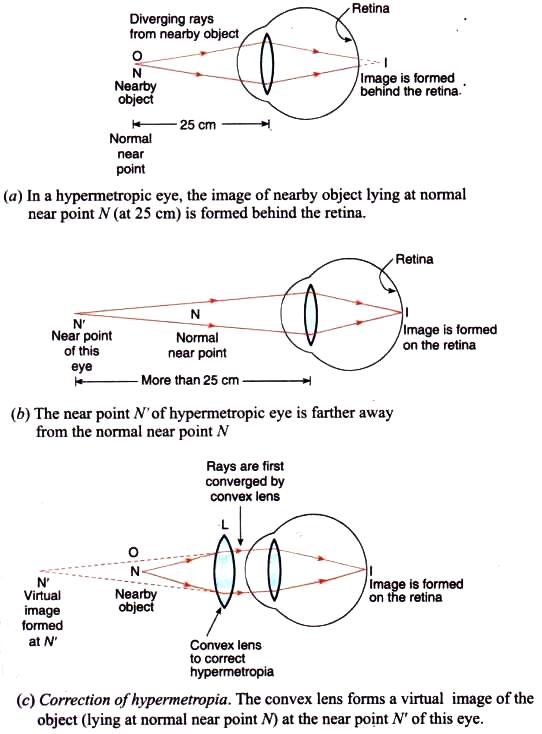
Question 24:
Name the defect of vision which can be corrected by a diverging lens. Show clearly by a ray diagram how the lens corrects the defect.
Solution :
Myopia can be corrected by a diverging lens.
Correction of myopia is given in the following diagram:
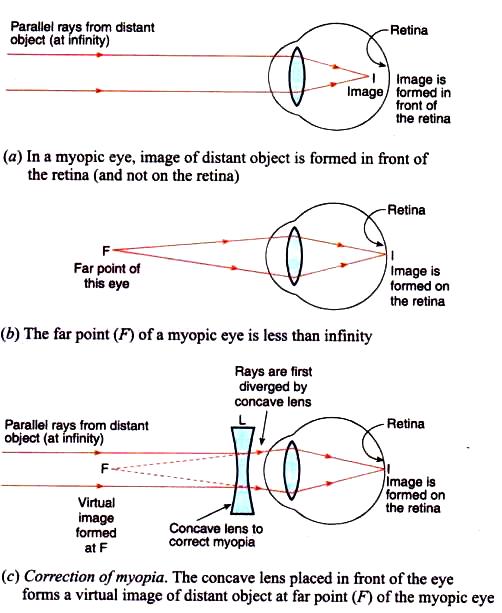
Question 25:
Explain with the help of labelled ray diagram, the defect of vision called myopia and how it is corrected by a lens.
Solution :
Myopia or short sightedness is that defect of vision due to which a person cannot see the distance objects clearly (though he can see the nearby objects clearly). This eye defect can be corrected by using a concave lens.
Myopic eye and its correction is given in the following diagrams

Question 26:
Explain with the help of labelled ray-diagram, the defect of vision called hypermetropia, and how it is corrected by a lens.
Solution :
Hypermetropia (or long-sightedness) is that defect of vision due to which a person cannot see the nearby objects clearly (though he can see the distant object clearly). This eye defect can be corrected by using a convex lens.
Hypermetropic eye and its correction is given in the following diagrams:

Question 27:
A person suffering from the eye-defect myopia (short-sightedness) can see clearly only up to a distance of 2 metres. What is the nature and power of lens required to rectify this defect ?
Solution :

Question 28:
The near-point of a person suffering from hypermetropia is at 50 cm from his eye. What is the nature and power of the lens needed to correct this defect ? (Assume that the near-point of the normal eye is 25 cm).
Solution :

Question 29:
A person needs a lens of power, – 5.5 dioptres for correcting his distant vision. For correcting his near vision, he needs a lens of power, +1.5 dioptres. What is the focal length of the lens required for correcting
distant vision, and
near vision ?
Solution :
For distant vision:
P = -5.5D
P = 1/f
f = 1/P = 1/(-5.5) = -0.1818 m = -18.18cm
For Near Vision:
P = 1.5D
P = 1/f
f = 1/P = 1/1.5 = 0.6666 = 66.66 cm
Question 30:
What is presbyopia ? Write two causes of this defect. Name the type of lens which can be used to correct presbyopia.
Solution :
Presbyopia is that defect of vision due to which an old person cannot see the nearby objects clearly due to loss of power of accommodation of the eye.
Causes: Gradual weakening of the ciliary muscles and diminishing flexibility of the eye lens.
It can be corrected by using convex lenses.
Question 31:
When is a person said to have developed cataract in his eye ? How is the vision of a person having cataract restored ?
Solution :
A person is said to have developed cataract when the eye lens becomes progressively cloudy resulting in blurred vision.
The vision of a person having cataract can be restored after getting surgery done on the eye having cataract. The opaque lens is removed from the eye by surgical operation and a new artificial lens is inserted in its place.
Question 32:
Fill in the following blanks with suitable words :
A person is short-sighted if his eyeball is too……………. Spectacles with a………… lens are needed. A person
is long-sighted if his eyeball is too……………. Spectacles with a …………. lens are needed. These focus light
rays exactly on to the………..
Solution :
long, concave, short, convex, retina
Question 33:
(a) What is short-sightedness ? State the two causes of short-sightedness (or myopia). With the help of ray
diagrams, show :
the eye-defect short-sightedness.
correction of short-sightedness by using a lens.
(b) A person having short-sight cannot see objects clearly beyond a distance of 1.5 m. What would be the nature and power of the corrective lens to restore proper vision ?
Solution :
(a) Short Sightedness is that defect of vision due to which a person can see nearby objects clearly but cannot see distant objects clearly.
Causes:
1. Excessive curvature of the eye lens
2. Elongation of the eyeball
Ray diagram for:
(i) eye-defect short sightedness


Question 34:
(a) What is long-sightedness ? State the two causes of long-sightedness (or hypermetropia). With the help of ray diagrams, show :
the eye-defect long-sightedness.
correction of long-sightedness by using a lens.
(b) An eye has a near point distance of 0.75 m. What sort of lens in spectacles would be needed to reduce the near point distance to 0.25 m ? Also calculate the power of lens required. Is this eye long-sighted or shortsighted ?
(c) An eye has a far point of 2 m. What type of lens in spectacles would be needed to increase the far point to infinity ? Also calculate the power of lens required. Is this eye long-sighted or short-sighted ?
Solution :
(a) Long-sightedness is that defect of vision due to which a person cannot see the nearby objects clearly but he can see the distant objects clearly.
Causes:
1. Focal length of the eye lens is too long.
2. The eyeball has become too small.
Ray diagram for:
(i) eye-defect long-sightedness
Question 47:
In a certain murder investigation, it was important to discover whether the victim was long-sighted or short-sighted. How could a detective decide by examining his spectacles ?
Solution :
If the spectacle lenses are convex, the person was long sighted and if the spectacle lenses are concave, the person was short sighted.
Question 48:
The picture given here shows a person wearing ‘half-moon’ spectacles. What sort of eye-defect do you think he has ? Why are these particular spectacles useful to him ?
Solution :
Half moon spectacles are used for reading. so, the person has long-sightedness.
These particular spectacles are useful to him since the convex lenses of spectacles form the image of nearby object (like a book in hand) at the near point of his eye.
Question 49:
A short-sighted person has a near point of 15 cm and a far point of 40 cm.
(a) Can he see clearly an object at a distance of:
(i) 5 cm ? (ii) 25 cm ? (iii) 50 cm ?
(b) To see clearly an object at infinity, what kind of spectacle lenses does he need ?
Solution :
(a) (i) No, (ii) Yes, (iii) No
(b) Concave lenses
Question 50:
The near point of a long-sighted person is 50 cm from the eye.The near point of a long-sighted person is 50 cm from the eye.
(a) Can she see clearly an object at :
(i) a distance of 20 cm ?
(ii) at infinity ?
(b) To read a book held at a distance of 25 cm, will she need converging or diverging spectacle lenses ?
Solution :
(a) (i) No, (ii) Yes
(b) Converging lenses
Question 51:
A person can read a book clearly only if he holds it at an arm’s length from him. Name the defect of vision :
(a) if the person is an old man
(b) if the person is a young man
Solution :
(a) Presbyopia
(b) Hypermetropia
Question 1:
How much is our field of view :
(a) with one eye open ?
(b) with both eyes open ?
Solution :
(a) About 150o
(b) About 180o
Question 2:
Which of the following have a wider field of view ?
(a) Animals having two eyes on the opposite sides of their head.
(b) Animals having two eyes at the front of their head.
Solution :
Animals having two eyes on the opposite sides of their head.
Question 3:
Out of animals of prey and predators, which have their eyes :
at the front of their head ?
on the opposite sides of their head ?
Solution :
Predators
Animals of prey
Question 4:
State whether the following statement is true or false :
Rabbit has eyes which look sideways.
Solution :
True
Question 5:
Fill in the following blanks with suitable words :
(a) Having two eyes gives a…………. field of view.
(b) Having two eyes enables us to judge………….. more accurately.
Solution :
(a) wider
(b) distances
Question 6:
What are the advantages of having two eyes instead of just one ?
Solution :
Following are the advantages of having two eyes instead of one:
1. Having two eyes gives a wider field of view.
2. Having two eyes enables us to judge distances more accurately.
Question 7:
Explain clearly why, a person who has lost the sight of one eye is at a disadvantage compared with the normal person who has two good eyes.
Solution :
A person who has lost the sight of one eye has a narrower field of view than the normal person who has two good eyes. Also, the person with one eye cannot judge distances accurately.
Question 8:
Name two animals having eyes :
(a) on the sides of the head.
(b) at the front of the head.
Solution :
(a) Rabbit, deer
(b) Tiger, lion
Question 9:
Among animals, the predators (like lions) have their eyes facing forward at the front of their heads, whereas the animals of prey (like rabbit) usually have eyes at the sides of their head. Why is this so ?
Solution :
The predators (like lions) have their eyes facing forward at the front of their heads, whereas the animals of prey (like rabbit) usually have eyes at the sides of their head so that they can see their enemies (predators) in a very large area around them and try to escape from them.
Question 10:
Five persons A, B, C, D and E have diabetes, leukaemia, asthma, meningitis and hepatitis, respectively.
(a) Which of these persons can donate eyes ?
(b) Which of these persons cannot donate eyes ?
Solution :
(a) A and C
(b) B, D and E
Lakhmir Singh Physics Class 10 Solutions Page No:288
Question 1:
As light rays pass from air into a glass prism, are they refracted towards or away from the normal ?
Solution :
Towards the normal
Question 2:
As light rays emerge from a glass prism into air, are they refracted towards or away from the normal ?
Solution :
Away from the normal
Question 3:
Name a natural phenomenon which is caused by the dispersion of sunlight in the sky.
Solution :
Rainbow
Question 4:
What information do we get about sunlight from the formation of a rainbow ?
Solution :
Sunlight consists of seven colours.
Question 5:
What did Newton demonstrate by his experiments with the prism ?
Solution :
Newton demonstrated by his experiments with the prisms that white light consists of a mixture of seven colours.
Question 6:
What colours make up white light ?
Solution :
Seven colours – Violet, indigo, blue, green, yellow, orange, red
Question 7:
Give the meaning of the term VIBGYOR. With which phenomenon is it connected ?
Solution :
The seven colours of the spectrum of white light are denited by the word VIBGYOR where V stands for Violet, I for Indigo, B for Blue, G for Green, Y for Yellow, O for Orange and R for Red.
It is connected with the phenomenon of dispersion of light.
Question 8:
In the formation of spectrum of white light by a prism :
which colour is deviated least ?
which colour is deviated most ?
Solution :
Red
Violet
Question 9:
What colours lie on the two sides of the ‘green colour’ in the spectrum of white light ?
Solution :
Yellow and Blue
Question 10:
Name the scientist who discovered that sunlight consists of seven colours.
Solution :
Newton
Question 11:
What is the order of colours in a rainbow, from the outside to the inside ?
Solution :
Red, Orange, Yellow, Green, Blue, Indigo and Violet